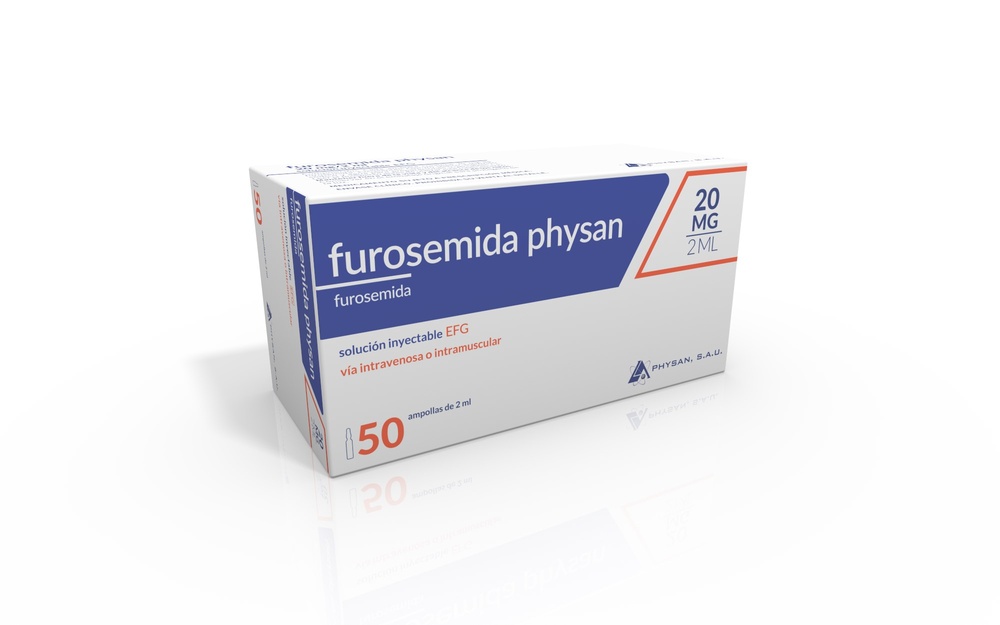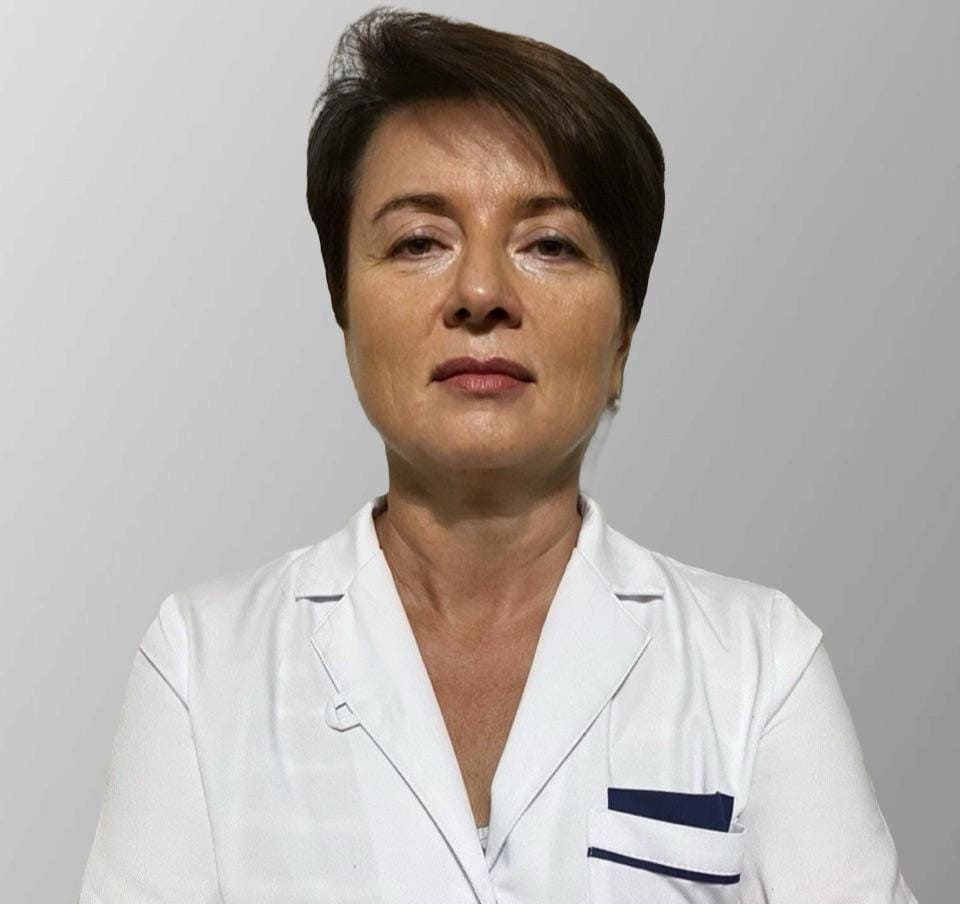

FUROSEMIDA PHYSAN 20mg/2ml SOLUÇÃO INJETÁVEL

Pergunte a um médico sobre a prescrição de FUROSEMIDA PHYSAN 20mg/2ml SOLUÇÃO INJETÁVEL

Como usar FUROSEMIDA PHYSAN 20mg/2ml SOLUÇÃO INJETÁVEL
Introdução
Prospecto: informação para o paciente
Furosemida Physan 20 mg/2 ml solução injetável EFG
Furosemida
Leia todo o prospecto detenidamente antes de começar a usar este medicamento, porque contém informações importantes para si.
- Conserva este prospecto, porque pode ter que voltar a lê-lo.
- Se tiver alguma dúvida, consulte o seu médico ou farmacêutico.
- Este medicamento foi prescrito apenas para si, e não deve dá-lo a outras pessoas, mesmo que tenham os mesmos sintomas que si, porque pode prejudicá-las.
- Se experimentar efeitos adversos, consulte o seu médico ou farmacêutico, mesmo que se trate de efeitos adversos que não aparecem neste prospecto. Ver seção 4.
Conteúdo do prospecto:
- O que é Furosemida Physan 20 mg/2 ml solução injetável e para que se utiliza
- O que precisa saber antes de começar a usar Furosemida Physan 20 mg/2 ml solução injetável
- Como usar Furosemida Physan 20 mg/2 ml solução injetável
- Possíveis efeitos adversos
- Conservação de Furosemida Physan 20 mg/2 ml solução injetável
- Conteúdo do envase e informações adicionais
1. O que é Furosemida Physan 20 mg/2 ml solução injetável e para que se utiliza
Furosemida é um diurético (agente que aumenta a eliminação de urina e diminui a pressão arterial) que pertence ao grupo das sulfonamidas.
Sempre sob prescrição do seu médico, este medicamento está indicado para o tratamento de:
- Edema (inchaço por acumulação de líquidos) associado a insuficiência cardíaca congestiva, cirrose hepática (ascite), e doença renal, incluindo síndrome nefrótico (tem prioridade o tratamento da doença básica).
- Edema de pulmão (sua administração é feita conjuntamente com outras medidas terapêuticas).
- Oliguria (diminuição da produção de urina) derivada de complicações do embarazo (gestose) após a compensação da volemia (volume total de sangue em uma pessoa).
- Como medida coadjuvante no edema cerebral.
- Edemas subsequentes a queimaduras.
- Crisis hipertensivas, juntamente com outras medidas hipotensoras.
- Manutenção da diurese forçada em intoxicações.
2. O que precisa saber antes de começar a usar Furosemida Physan
Não use Furosemida Physan:
- se é alérgico à furosemida, a medicamentos do tipo de furosemida (sulfonamidas) ou a algum dos outros componentes deste medicamento (incluídos na seção 6).
- No caso de que diminua seu volume total de sangue (hipovolemia) ou sofra desidratação.
- se sofre problemas graves nos rins, acompanhados de uma diminuição na eliminação de urina (insuficiência renal com anuria), que não responda a este medicamento.
- se diminui gravemente seu nível de potássio no sangue (hipopotasemia grave), ver apartado 4 ”Possíveis efeitos adversos”.
- se sofre deficiência de sais de sódio no sangue (hiponatremia grave).
- em caso de estar em estado pré-comatoso e comatoso hepático (associado a encefalopatia hepática).
- se está amamentando um bebê
- se está grávida, ver apartado 2 “Embarazo, lactância e fertilidade”.
Advertências e precauções
Consulte o seu médico ou farmacêutico antes de começar a tomar Furosemida Physan:
Tenha especial cuidado com este medicamento:
- Se tem problemas de eliminação de urina, sobretudo no início do tratamento.
- Se sua pressão arterial é baixa (hipotensão).
- Se tem um risco especial de sofrer um descenso pronunciado da pressão arterial (por exemplo, em pacientes com estenose coronária ou cerebral significativa).
- Se padece diabetes mellitus latente ou manifesta.
- Se sofre gota.
- Se tem problemas graves nos rins, associados a uma doença grave do fígado (síndrome hepatorrenal).
- Se seus níveis de proteínas no sangue são baixos (hipoproteinemia), além de padecer, por exemplo, um síndrome nefrótico (ver apartado 4 “Possíveis efeitos adversos”).
- Em crianças prematuras (ver apartado 4 “Possíveis efeitos adversos”).
- Existe a possibilidade de uma exacerbção ou ativação de lúpus eritematoso sistêmico.
- Se você é uma pessoa de idade avançada, se está sendo tratado com medicamentos que possam causar diminuição da pressão sanguínea ou se apresenta outros quadros médicos que tenham associado o risco de diminuição da pressão sanguínea.
Durante seu tratamento com furosemida, geralmente será necessário um controle periódico de seus níveis no sangue de sódio, potássio e creatinina, e em especial se você sofre uma perda grave de líquidos, por vômitos, diarreia ou sudorese intensa. Devem ser corrigidas a desidratação ou a hipovolemia, assim como qualquer alteração eletrolítica e do equilíbrio ácido-básico significativas, porque isso pode requerer a interrupção do tratamento.
Os pacientes de idade avançada com demência que estão tomando risperidona devem ter especial cuidado com o uso concomitante de risperidona e furosemida. A risperidona é um medicamento que se utiliza para tratar certas doenças mentais, como a demência (doença que se caracteriza por apresentar vários sintomas: perda de memória, problemas para falar, problemas para pensar).
Outros medicamentos e Furosemida Physan
Informe o seu médico ou farmacêutico se está utilizando, utilizou recentemente ou pudesse ter que utilizar qualquer outro medicamento.
Não se recomenda a administração de furosemida intravenosa durante as 24 horas após ser administrado hidrato de cloral, porque poderia dar lugar a rubores, sudorese, intranquilidade, náuseas, hipertensão e taquicardia.
Algumas substâncias podem ver aumentada sua toxicidade no ouvido e nos rins, se forem administradas juntamente com este medicamento. Daí que, se forem administradas conjuntamente, seja sob estrito controle médico. Entre estas substâncias estão:
- Antibióticos aminoglicosídeos (medicamentos para as infecções) tipo gentamicina, kanamicina e tobramicina.
- Medicamentos para o câncer (cisplatina).
Este medicamento pode debilitar o efeito de outros medicamentos como:
- Medicamentos usados para a diabetes (antidiabéticos).
- Medicamentos usados para elevar a pressão arterial (simpaticomiméticos com efeito hipertensor, por exemplo, epinefrina e norepinefrina).
Também pode aumentar a ação de outros medicamentos como:
- Medicamentos para a asma (teofilina).
- Relaxantes musculares tipo curare.
- Medicamentos para a depressão (lítio), podendo aumentar o risco de toxicidade do lítio, incluindo o risco de efeitos perjudiciais sobre o coração ou o cérebro.
- Os pacientes que estiverem em tratamento com diuréticos podem sofrer uma hipotensão grave e o deterioro da função renal, especialmente quando se administra pela primeira vez ou se administra pela primeira vez uma dose elevada de um inibidor da ECA (Enzima Conversora da Angiotensina) ou um antagonista dos receptores de angiotensina II.
- Se se administram medicamentos para tratar a tensão alta, diuréticos, ou outros medicamentos que possam diminuir a tensão, conjuntamente com furosemida, se deve prever um descenso mais pronunciado na tensão arterial.
- Medicamentos tóxicos para os rins: a administração conjunta pode potenciar o efeito nocivo destes medicamentos sobre os rins.
Algumas substâncias para a inflamação e a dor, (anti-inflamatórios não esteroideos, incluindo ácido acetilsalicílico) podem reduzir o efeito de furosemida.
Os medicamentos como probenecid e metotrexato ou outros medicamentos que tenham uma eliminação significativa pelos rins podem reduzir o efeito de furosemida. Em tratamento com altas doses, podem aumentar os níveis séricos e aumentar o risco de efeitos adversos devido à furosemida ou à administração concomitante.
As seguintes substâncias podem aumentar o risco de reduzir os níveis de potássio no sangue (hipopotasemia) se forem administradas com furosemida:
- Medicamentos para a inflamação (corticosteroides).
- Carbenoxolona (medicamento para o tratamento de lesões da mucosa oral).
- Quantidades importantes de alcaçuz.
- Uso prolongado de laxantes para o estreñimento.
Algumas alterações eletrolíticas (por exemplo, a diminuição no sangue dos níveis de potássio (hipopotasemia) ou de magnésio (hipomagnesemia)) poderiam aumentar a toxicidade de alguns medicamentos (por exemplo, medicamentos digitálicos e medicamentos indutores do síndrome de prolongamento do intervalo QT).
Os pacientes em tratamento com furosemida e que recebem altas doses de algumas cefalosporinas (antibióticos) podem sofrer uma diminuição da função dos rins.
A administração conjunta de furosemida e ciclosporina A (medicamento utilizado para evitar o rejeição de transplantes) se associa com um risco elevado de artrite gotosa (inflamação das articulações) secundária a um aumento do nível de ureia no sangue (hiperuricemia) e a problemas de eliminação da ureia pelos rins.
Aqueles pacientes com alto risco de sofrer uma nefropatia (doença dos rins) por radiocontraste que recebem furosemida têm mais possibilidades de sofrer deterioro da função dos rins.
A administração de furosemida juntamente com risperidona em pacientes de idade avançada com demência, poderia aumentar a mortalidade.
Altas doses de furosemida administradas com levotiroxina podem levar a um aumento inicial transitório das hormonas tireoidianas livres, seguido de um descenso geral dos níveis totais de hormona tireoidiana.
Embarazo e lactância
Se está grávida ou em período de lactância, acredita que possa estar grávida ou tem intenção de ficar grávida, consulte o seu médico ou farmacêutico antes de utilizar este medicamento.
Em caso de estar grávida, furosemida só será administrada sob estrita indicação do seu médico.
Durante a lactância, não deve ser administrada furosemida. Em caso que a sua administração resulte imprescindível, o seu médico pode requerer que interrompa a lactância, porque Furosemida passa para o leite materno.
Condução e uso de máquinas
Este medicamento pode produzir marejos ou sonolência. Isso pode ocorrer com maior frequência no início do tratamento, quando o seu médico aumentar a dose ou se consumir álcool. Não conduza nem maneje ferramentas ou máquinas se se sentir mareado ou sonolento.
Alguns efeitos adversos (p. ex. uma queda pronunciada não desejável da tensão arterial) pode prejudicar a capacidade para concentrar-se e de reação, e, portanto, constitui um risco em situações em que estas habilidades são de especial importância (p. ex. operar com veículos ou maquinaria).
Furosemida Physan contém sódio
Este medicamento contém menos de 1mmol de sódio (23 mg) por ampola, isto é, essencialmente “isento de sódio”.
3. Como usar Furosemida Physan 20 mg/2 ml solução injetável
Siga exatamente as instruções de administração deste medicamento indicadas pelo seu médico ou farmacêutico. Em caso de dúvida, consulte novamente o seu médico ou farmacêutico.
Furosemida pode ser administrada por via intravenosa ou intramuscular. Estas vias estão indicadas quando a sua absorção intestinal se encontrar alterada ou seja necessária uma eliminação rápida de líquidos.
A administração intramuscular será utilizada quando a administração oral ou intravenosa não forem possíveis. Não se recomenda esta via em situações graves como edema pulmonar.
A substância ativa furosemida por via intravenosa deve ser injetada ou perfundida lentamente a uma velocidade não superior a 4 mg por minuto. Em pacientes com problemas graves nos rins (creatinina sérica > 5 mg/dl), se recomenda que a velocidade de perfusão não exceda 2,5 mg por minuto.
Furosemida em forma de solução injetável não deve ser misturada na mesma seringa nem perfundida juntamente com outros medicamentos.
Seu médico ou enfermeiro devem ter em conta que o valor de pH da solução a perfundir deve ser neutro ou ligeiramente alcalino e, portanto, não devem empregar soluções ácidas, porque o princípio ativo poderia precipitar. O soro salino isotônico é o diluente adequado. Se recomenda que a solução pronta para a administração seja utilizada o mais cedo possível.
Seu médico lhe indicará a sua dose diária e a duração do seu tratamento. Não suspenda o seu tratamento antes. A dose é específica para si e poderá ser modificada pelo seu médico em função da sua resposta ao tratamento.
Em adultos: a dose máxima recomendada de furosemida é de 1.500 mg diários, embora em casos excepcionais se possa chegar a 2.000 mg.
Uso em crianças e adolescentes
A dose diária máxima recomendada de furosemida em crianças para administração parenteral é de 1 mg de furosemida por kg de peso corporal até um máximo de 20 mg de furosemida ao dia. Em quanto for possível, se mudará para o tratamento por via oral.
Em lactentes e em crianças menores de 15 anos: a administração de furosemida por via parenteral (eventualmente em perfusão lenta) está contraindicada, só se efetuará nos casos em que suponha um risco vital.
Se usa mais Furosemida Physan 20 mg/2 ml Solução injetável do que deve
Em caso de sobredose ou ingestão acidental, consulte imediatamente o seu médico ou dirija-se ao serviço de urgências do hospital mais próximo, acompanhado deste prospecto ou ligue ao Serviço de Informação Toxicológica, telefone 91 562 04 20, indicando o medicamento e a quantidade ingerida ou administrada.
Uma sobredose acidental poderia dar lugar a uma diminuição grave da pressão arterial (que pode evoluir para choque), problemas nos rins (insuficiência renal aguda), problemas na coagulação (trombose), delírio, paralisia que afeta músculos brandos (paralisia flácida), apatia e confusão.
Não se conhece um antídoto específico.
Em caso de sobredose, o tratamento será em função dos sintomas.
Se esqueceu de usar Furosemida Physan 20 mg/2 ml Solução injetável
Não use uma dose dupla para compensar as doses esquecidas
Se tiver alguma outra dúvida sobre o uso deste produto, pergunte ao seu médico ou farmacêutico.
4. Possíveis efeitos adversos
Tal como todos os medicamentos, Furosemida Physan pode produzir efeitos adversos, embora nem todas as pessoas os sofram.
Foram agrupados os efeitos adversos de acordo com a sua frequência:
Muito frequentes(podem afetar mais de 1 em cada 10 doentes)
- alterações de eletrólitos (incluindo as sintomáticas), desidratação e descida do volume total de sangue (hipovolemia), em particular em doentes de idade avançada, nível elevado de creatinina e de triglicéridos no sangue.
- com perfusão intravenosa: descida da pressão arterial (hipotensão, incluindo hipotensão ortostática (problemas para manter a posição erecta).
Frequentes(podem afetar até 1 em cada 10 doentes)
- diminuição dos níveis de sódio (hiponatremia), de cloro (hipocloremia), de potássio (hipopotasemia), aumento dos níveis de colesterol e de ácido úrico no sangue e ataques de gota.
- aumento do volume de urina.
- alterações mentais (encefalopatia hepática) em doentes com problemas hepáticos (insuficiência hepatocelular).
- aumento da viscosidade do sangue (hemoconcentração).
Pouco frequentes(podem afetar até 1 em cada 100 doentes)
- alteração da tolerância à glicose. Pode manifestar-se uma diabetes mellitus latente.
- náuseas.
- distúrbios auditivos, embora normalmente de caráter transitório, em especial em doentes com insuficiência renal, diminuição do nível de proteínas no sangue (hipoproteinemia) e/ou após uma administração intravenosa demasiado rápida de furosemida. Surdez (por vezes, irreversível).
- prurido, erupções cutâneas, rash, bolhas e outras reações mais graves, como eritema multiforme, penfigoide, dermatite exfoliativa, púrpura e reação de fotosensibilidade.
- diminuição dos níveis de plaquetas (trombocitopenia).
Raros(podem afetar até 1 em cada 1000 doentes)
- inflamação alérgica dos vasos sanguíneos (vasculite).
- reação renal de tipo alérgico (nefrite tubulointersticial).
- vómitos, diarreia.
- sensação subjetiva de tinido (tinnitus).
- reações alérgicas (anafilácticas ou anafilactoides) graves (p. ex. com choque).
- sensação de formigamento nos membros (parestesias).
- diminuição do nível de glóbulos brancos (leucopenia), aumento de um tipo de glóbulos brancos, os eosinófilos (eosinofilia).
- febre.
Muito raros(podem afetar até 1 em cada 10.000 doentes)
- inflamação do pâncreas (pancreatite aguda).
- problema do fígado (colestase), incremento das enzimas do fígado (transaminases).
- diminuição de um tipo de glóbulos brancos, os granulócitos (agranulocitose), diminuição do número de glóbulos vermelhos (anemia aplásica ou anemia hemolítica).
Frequência desconhecida(não pode ser estimada a partir dos dados disponíveis)
- diminuição dos níveis de cálcio (hipocalcemia), de magnésio (hipomagnesemia), aumento do nível de ureia no sangue, alcalose metabólica, síndrome de pseudo-Bartter no caso de uso indevido e/ou uso prolongado de furosemida.
- alteração da coagulação do sangue (trombose).
- aumento do nível de sódio e cloro na urina, retenção de urina (em doentes com obstrução parcial do fluxo de urina), formação de cálculos nos rins (nefrocalcinose/nefrolitíase) em crianças prematuras, falha renal.
- reações vesiculares graves da pele e das membranas mucosas (síndrome de Stevens-Johnson), alteração grave da pele caracterizada pela formação de bolhas e lesões exfoliativas (necrólise epidérmica tóxica), pustulose exantemática generalizada aguda (PEGA) e síndrome de hipersensibilidade a medicamentos com eosinofilia e sintomas sistémicos (DRESS), reações liquenoides, caracterizadas como lesões pequenas, que produzem prurido, de cor roxa, com forma poligonal, que aparecem na pele, nos genitais ou na boca.
- exacerbação ou ativação do lúpus eritematoso sistémico.
- tontura, desmaios e perda de consciência, dor de cabeça.
- foram comunicados casos de rabdomiólise, frequentemente em casos em que se padece uma diminuição do nível de potássio no sangue (hipopotasemia) grave (ver apartado “Não use Furosemida Physan”).
- aumento do risco de persistência do ducto “ductus arterioso permeável” quando se administra furosemida a crianças prematuras durante as primeiras semanas de vida.
- após a injeção intramuscular de furosemida, podem aparecer reações locais, como dor na zona de injeção.
Tal como com outros diuréticos, após a administração prolongada deste medicamento pode aumentar a eliminação de sódio, cloro, água, potássio, cálcio e magnésio. Estas alterações manifestam-se com sede intensa, dor de cabeça, confusão, cãibras musculares, contração dolorosa dos músculos, especialmente dos membros (tetania), fraqueza muscular, alterações do ritmo cardíaco e sintomas gastrointestinais.
Comunicação de efeitos adversos
Se experimenta qualquer tipo de efeito adverso, consulte o seu médico ou farmacêutico, mesmo que se trate de possíveis efeitos adversos que não aparecem neste prospecto. Também pode comunicá-los directamente através do Sistema Espanhol de Farmacovigilância de Medicamentos de Uso Humano: https://www.notificaram.es. Mediante a comunicação de efeitos adversos, você pode contribuir para proporcionar mais informações sobre a segurança deste medicamento.
5. Conservação de Furosemida Physan 20mg/ 2ml Solução injetável
Mantenha este medicamento fora da vista e do alcance das crianças.
Conservar no embalagem original para protegê-lo da luz.
Não utilize este medicamento após a data de validade que aparece na ampola e no envase, após CAD. A data de validade é o último dia do mês que se indica.
A solução não utilizada deve ser eliminada de acordo com as normas locais.
Os medicamentos não devem ser jogados pelos deságues nem na lixeira. Em caso de dúvida, pergunte ao seu farmacêutico como se livrar dos envases e dos medicamentos que não precisa. Dessa forma, ajudará a proteger o meio ambiente.
6. Conteúdo do envase e informações adicionais
Composição deFurosemida Physan20 mg/2 ml Solução injetável
O princípio ativo é furosemida. Cada ampola de 2 ml contém 20 mg de furosemida, correspondente a 10 mg de furosemida por ml de solução injetável.
Os outros componentes são: cloreto de sódio, hidróxido de sódio e água para preparações injetáveis.
Aspecto do produto e conteúdo do envase
Furosemida Physan 20 mg/2 ml Solução injetável está envasado em ampolas de vidro.
Este medicamento é apresentado em caixas contendo 5 ampolas, 50 ampolas (envase clínico) ou 100 ampolas (envase clínico) de vidro de 2 ml.
Título da autorização de comercialização e responsável pela fabricação
Título da autorização de comercialização
Laphysan S.A.U.
Anabel Segura, 11 Edifício A, Piso 4, Porta D
28108 Alcobendas (Madrid)
Espanha
Responsável pela fabricação
Laboratórios Inibsa, S.A. Ctra. Sabadell a Granollers, km 14,5
08185 Lliçà de Vall – Barcelona
Espanha
Ou
Laboratórios Basi-Indústria farmacêutica, S.A.
Parque Industrial Manuel Lourenço Ferreira, nº 8, 15 e 16.
3450-232 Mortágua-Portugal
Data da última revisão desteprospecto:Fevereiro 2023
A informação detalhada deste medicamento está disponível na página Web da Agência Espanhola de Medicamentos e Produtos Sanitários (AEMPS) http://www.aemps.gob.es/
Esta informação está destinada unicamente a médicos ou profissionais do sector sanitário
Furosemida não deve ser misturada na mesma seringa com nenhum outro medicamento.
A furosemida é solúvel em meio alcalino em forma de antranilato. A solução para administração parenteral contém a sal sódica do ácido carboxílico sem qualquer solubilizante; tem um pH de 9 e não possui ação tampão, por isso um valor de pH inferior a 7 pode precipitar o princípio ativo. As misturas podem ser guardadas, até 24 horas como máximo, se o pH da solução final for neutro ou alcalino débil.
Nas intoxicações por substâncias ácidas ou básicas pode aumentar a taxa de eliminação como consequência da acidificação ou alcalinização da urina.
- País de registo
- Substância ativa
- Requer receita médicaSim
- Fabricante
- Esta informação é apenas para referência e não constitui aconselhamento médico. Consulte sempre um médico antes de tomar qualquer medicamento. A Oladoctor não se responsabiliza por decisões médicas baseadas neste conteúdo.
- Alternativas a FUROSEMIDA PHYSAN 20mg/2ml SOLUÇÃO INJETÁVELForma farmacêutica: COMPRIMIDO, 40 mgSubstância ativa: furosemideFabricante: Uxa Farma S.A.Requer receita médicaForma farmacêutica: PERFURAÇÃO INJETÁVEL, 10 mg/mLSubstância ativa: furosemideFabricante: Altan Pharmaceuticals SaRequer receita médicaForma farmacêutica: COMPRIMIDO, 40 mgSubstância ativa: furosemideFabricante: Laboratorios Alter S.A.Requer receita médica
Alternativas a FUROSEMIDA PHYSAN 20mg/2ml SOLUÇÃO INJETÁVEL noutros países
As melhores alternativas com o mesmo princípio ativo e efeito terapêutico.
Alternativa a FUROSEMIDA PHYSAN 20mg/2ml SOLUÇÃO INJETÁVEL em Polónia
Alternativa a FUROSEMIDA PHYSAN 20mg/2ml SOLUÇÃO INJETÁVEL em Ukraine
Médicos online para FUROSEMIDA PHYSAN 20mg/2ml SOLUÇÃO INJETÁVEL
Avaliação de posologia, efeitos secundários, interações, contraindicações e renovação da receita de FUROSEMIDA PHYSAN 20mg/2ml SOLUÇÃO INJETÁVEL – sujeita a avaliação médica e regras locais.










